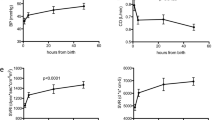Abstract
This study determined the accuracy and validity for the haemodynamic parameters of haemodynamically stable neonates after postnatal circulatory adaptation using the ultrasonic cardiac output monitor (USCOM) in comparison with echocardiography. We conducted a prospective, observational study of neonates born at 23–41 weeks of gestation. They all underwent both echocardiography and USCOM assessments for comparison purposes. The 127 neonates were examined at the median of postmenstrual age of 35 weeks and there was a very high correlation between the cardiac output measurements provided by both methods. The mean difference in cardiac output was − 12 ± 25 ml/kg/min, with percentage error of 8.3 ± 6.9%. A larger bias was observed in cases with higher left ventricular output. Bland–Altman analysis confirmed no significant bias, with acceptable limits of agreement between these two methods. There was a very good correlation between the USCOM and echocardiographic methods when we used them to measure cardiac output in neonates.


Similar content being viewed by others
References
Elgendy A, Seppelt IM, Lane AS. Comparison of continous-wave Doppler ultrasound monitor and echocardiography to assess cardiac output in intensive care patients. Crit Care Resusc. 2017;19(3):222–9.
Singh Y. Echocardiographic Evaluation of Hemodynamics in Neonates and Children. Front Pediatr. 2017;5:201.
Singh Y, Roehr CC, Tissot C, Rogerson S, Gupta S, Bohlin K, et al. Education, training, and accreditation of Neonatologist Performed Echocardiography in Europe-framework for practice. Pediatr Res. 2018;84(Suppl 1):13–7.
Chaiyakulsil C, Chantra M, Katanyuwong P, Khositseth A, Anantasit N. Comparison of three non-invasive hemodynamic monitoring methods in critically ill children. 2018;13(6):e0199203.
Nguyen HB, Banta DP, Stewart G, Kim T, Bansal R, Anholm J, et al. Cardiac index measurements by transcutaneous Doppler ultrasound and transthoracic echocardiography in adult and pediatric emergency patients. J Clin Monit Comput. 2010;24(3):237–47.
Brierley J, Peters MJ. Distinct hemodynamic patterns of septic shock at presentation to pediatric intensive care. Pediatrics. 2008;122(4):752–9.
Critchley LA, Peng ZY, Fok BS, Lee A, Phillips RA. Testing the reliability of a new ultrasonic cardiac output monitor, the USCOM, by using aortic flowprobes in anesthetized dogs. Anesth Analg. 2005;100(3):748–53.
Fraga MV, Dysart KC, Rintoul N, Chaudhary AS, Ratcliffe SJ, Fedec A, et al. Cardiac Output Measurement Using the Ultrasonic Cardiac Output Monitor: A Validation Study in Newborn Infants. Neonatology. 2019:1–9.
Phillips R, Paradisis M, Evans N, Southwell D, Burstow D, West M. Cardiac output measurement in preterm neonates: validation of USCOM against echocardiography. Crit Care. 2006;10(Suppl 1):P343.
Patel N, Dodsworth M, Mills JF. Cardiac output measurement in newborn infants using the ultrasonic cardiac output monitor: an assessment of agreement with conventional echocardiography, repeatability and new user experience. Arch Dis Child Fetal Neonatal Ed. 2011;96(3):F206–11.
Meyer S, Todd D, Shadboldt B. Assessment of portable continuous wave Doppler ultrasound (ultrasonic cardiac output monitor) for cardiac output measurements in neonates. J Paediatr Child Health. 2009;45(7–8):464–8.
Dey I, Sprivulis P. Emergency physicians can reliably assess emergency department patient cardiac output using the USCOM continuous wave Doppler cardiac output monitor. Emerg Med Australas. 2005;17(3):193–9.
Nidorf SM, Picard MH, Triulzi MO, Thomas JD, Newell J, King ME, et al. New perspectives in the assessment of cardiac chamber dimensions during development and adulthood. J Am Coll Cardiol. 1992;19(5):983–8.
Vieillard-Baron A, Slama M, Cholley B, Janvier G, Vignon P. Echocardiography in the intensive care unit: from evolution to revolution? Intensive Care Med. 2008;34(2):243–9.
Cattermole GN, Leung PY, Ho GY, Lau PW, Chan CP, Chan SS, et al. The normal ranges of cardiovascular parameters measured using the ultrasonic cardiac output monitor. Physiol Rep. 2017;5(6).
Cattermole GN, Leung PY, Mak PS, Chan SS, Graham CA, Rainer TH. The normal ranges of cardiovascular parameters in children measured using the Ultrasonic Cardiac Output Monitor. Crit Care Med. 2010;38(9):1875–81.
Dhanani S, Barrowman NJ, Ward RE, Murto KT. Intra- and inter-observer reliability using a noninvasive ultrasound cardiac output monitor in healthy anesthetized children. Paediatr Anaesth. 2011;21(8):858–64.
Beltramo F, Menteer J, Razavi A, Khemani RG, Szmuszkovicz J, Newth CJ, et al. Validation of an ultrasound cardiac output monitor as a bedside tool for pediatric patients. Pediatr Cardiol. 2016;37(1):177–83.
Phillips RA, Smith BE, Madigan VM. Stroke volume monitoring: novel continuous wave doppler parameters, algorithms and advanced noninvasive haemodynamic concepts. Curr Anesthesiol Rep. 2017;7(4):387–98.
Acknowledgements
Not applicable.
Funding
Not applicable.
Author information
Authors and Affiliations
Corresponding author
Ethics declarations
Conflict of interest
The authors declare that they have no conflict of interest.
Ethical approval
The study was authorised by the Vilnius Regional Biomedical Research Ethics Committee (12/09/2017, Identifier: 158200–17-910–452) and retrospectively registered with ClinicalTrials.gov (16/12/2019, Identifier: NCT04200807).
Informed consent
Written informed consent was obtained from the parents of all individual participants included in the study.
Additional information
Publisher's Note
Springer Nature remains neutral with regard to jurisdictional claims in published maps and institutional affiliations.
Rights and permissions
About this article
Cite this article
Pliauckiene, A., Liubsys, A., Vankeviciene, R. et al. Ultrasonic cardiac output monitor provides effective non-invasive bedside measurements of neonatal cardiac output. J Clin Monit Comput 36, 803–807 (2022). https://doi.org/10.1007/s10877-021-00711-2
Received:
Accepted:
Published:
Issue Date:
DOI: https://doi.org/10.1007/s10877-021-00711-2




